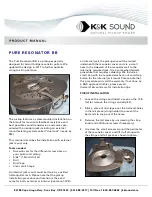
Front Panel Operation
2-23
CABLE LEAKAGE RESISTANCE
In an unguarded voltage measurement, leakage current oc-
curs in the input triax cable between the center conductor
(HI) and the inner shield (LO). This leakage resistance
shunts the voltage source to be measured. If the resistance of
the source is not significantly less than the leakage resistance
of the cable, then measurement errors will occur.
The effects of leakage resistance can be eliminated by using
guard to make high impedance voltage measurements. See
GUARDING for more information. In general, guarding
should be used when the resistance of the voltage source is
10
9
Ω
or greater.
INPUT CAPACITANCE
At very high resistance levels, the very large time constants
created by even a minimal amount of capacitance can slow
down response time considerably. For example, measuring a
source with an internal resistance of 100G
Ω
, would result in
an RC time constant of one second when measured through
a cable with a nominal capacitance of 10pF. If 1% accuracy
is required, a single measurement would require at least five
seconds.
Basically, there are two ways to minimize this problem: (1)
keep the input cable as short as possible, and (2) use guard-
ing. Of course there is a limit to how short the cable can be.
Using guard can reduce these effects by up to a factor of
1000 (see Guarding).
GUARDING
Guarding should be used for high-impedance voltage mea-
surements and for voltage measurements that use long input
cables. The basic procedure to make guarded voltage mea-
surements is provided in paragraph 2.5.1.
To understand the concept of guarding, let us first review the
unguarded circuit shown in Figure 2-23. E
S
and R
S
repre-
sents the resistance and voltage components of the source,
and R
L
and C
L
represents the leakage resistance and cable
capacitance of the triax input cable. The equivalent circuit
shows the divider that is formed. If R
S
is large enough, the
divider will significantly attenuate the voltage seen at the in-
put of the Model 6517A (see CABLE LEAKAGE RESIS-
TANCE). Also, R
S
and the cable capacitance (C
L
) could
create a long RC time constant resulting in a slow measure-
ment response (see INPUT CAPACITANCE).
Guarding the circuit minimizes these effects by driving the
inner shield of the triax cable at signal potential, as shown in
Figure 2-24. Here, a unity gain amplifier with a high input
impedance and low output impedance is used. Since the cen-
ter conductor (HI) and the inner shield (Guard) of the cable
are at virtually the same potential, the potential across R
L
is
zero, so no current flows. Also, with a zero potential across
C
L
, there is no capacitor charging process to slow down the
measurement response.
Figure 2-22
Meter loading
Source
Rs
V
Es
R
IN
Meter
% Error =
100R
S
R
S
+ R
IN
Inner Shield
Triax Cable
R
S
HI
To
6517A
Input
LO
E
S
R
L
C
L
Source
Center
Conductor
Equivalent Circuit
R
S
HI
To
6517A
Input
LO
E
S
R
L
C
L
Figure 2-23
Unguarded voltage measurements















































